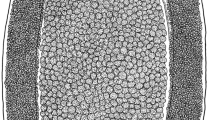Abstract
As part of a biological inventory of the Rio Lacantún basin in the Biosphere Reserve of Montes Azules from Chiapas State (southeastern, Mexico), the following monogenoid ectoparasites infecting the external surface of the anal opening and the gill lamellae of the freshwater fish Astyanax aeneus (Characidae) in ten streams were found: Cacatuocotyle chajuli sp. nov. (anus), Cacatuocotyle exiguum sp. nov., and Cacatuocotyle sp. (gill lamellae). C. chajuli is differentiated from its single congener, Cacatuocotyle paranaensis (Boeger et al. Syst Parasitol 36:75–78, 1997), from the gills of Characidium lanei (Characidae) from Paraná Brazil, in having a noticeably V-shaped haptoral bar and larger hooks and anchors. C. exiguum differs from these two latter species in the size of its anchors. Illustrations and data on morphological and biometric variability of individual specimens of C. chajuli and C. exiguum from different streams are provided. The present data support the statement about three species of Astyanax, which harbor the richest monogenoidean diversity in the Neotropics with a total of 18 species reported up to now. Occurrences of species of Cacatuocotyle on different sites of infection on three distant host species [including a Neotropical cichlid (Cichlidae) species] suggest that these monogenoideans switching to new hosts can result in the availability of potential hosts within the same habitat instead of showing signs of preferential switching between closely related hosts or on their respective microhabitats.



Similar content being viewed by others
References
Boeger WA, Domingues MV, Kritsky DC (1997) Neotropical Monogenoidea. 32. Cacatuocotyle paranaensis n. g., n. sp. (Dactylogyridae, Ancyrocephalinae) from Characidium spp. (Teleostei, Characidae) from the State of Paraná, Brazil. Syst Parasitol 36:75–78
Bush AO, Lafferty KD, Lotz JM, Shostak AW (1997) Parasitology meets ecology on its own terms: Margolis et al. revisited. J Parasitol 83:575–583
De la Maza R (1997) El paisaje. la vision primigenia. En: selva lacandona: Un paraíso en extinción. Pulsar, México, p 157
de Lozano-Vilano ML, García-Ramírez ME, Contreras-Balderas C, Ramírez-Martínez YC (2007) Diversity and conservation status of the Ichthyofauna of the Río Lacantún basin in the Biosphere Reserve Montes Azules, Chiapas, México. Zootaxa 1410:43–53
Froese R, Pauly D (Editors) (2012) FishBase. World Wide Web electronic publication, version (03/2008). www.fishbase.org
Greathouse AL (2010) (ed.) Manual para la conservación de la biodiversidad de la selva lacandona-estación Chajul. http://www.youblisher.com/p/28810-Proyecto-Natura/. Natura Mexicana 62
Kritsky DC, Fritts TH (1970) Monogenetic trematodes from Costa Rica with the proposal of Anacanthocotyle gen. n. (Gyrodactylidae: Isoancistrinae). Proc Helminthol Soc Wash 37:63–68
Kritsky DC, Leiby PD (1972) Dactylogyridae (Monogenea) from the freshwater fish, Astyanax fasciatus (Cuvier), in Costa Rica, with descriptions of Jainus hexops sp. n., Urocleidoides costaricensis, and U. heteroancistrium combs. n. Proc Helminthol Soc Wash 39:227–230
Kritsky DC, Mendoza-Franco EF (2003) Neotropical Monogenoidea. 42. Pavanelliela scaphiocotylus sp. nov. (Dactylogyridae) from the nasal cavity of the Guatemalan Chulin, Rhamdia guatemalensis (Siluriformes: Heptapteridae), from a cenote of the Yucatan, Peninsula, Mexico. Comp Parasitol 70:136–139
Kritsky DC, Mendoza-Franco E, Scholz T (2000) Neotropical Monogenoidea. 36. Dactylogyrids from the gills of Rhamdia guatemalensis (Siluriformes: Pimelodidae) from cenotes of the Yucatan Peninsula, Mexico with proposal of Ameloblastella gen. n. and Aphanoblastella gen. n. (Dactylogyridae, Ancyrocephalinae). Comp Parasitol 67:76–84
Mendoza Franco EF, Scholz T, Vivas Rodríguez C, Vargas Vázquez J (1999) Monogeneans of freshwater fishes from cenotes (sinkholes) of the Yucatan Peninsula, Mexico. Fol Parasitol 46:267–273
Mendoza-Franco EF, Reina RG (2008) Five new species of Urocleidoides (Monogenoidea) (Mizelle and Price 1964) Kritsky, Thatcher and Boeger, 1986 from the gills of Panamanian freshwater fishes. J Parasitol 94:793–802
Mendoza Franco EF, Reina RG, Torchin ME (2009) Dactylogyrids (Monogenoidea: Platyhelminthes) parasitizing the gills of Astyanax spp. (Characidae) from Panama and southeast Mexico, a new species of Diapharocleidus, and proposal for Characithecium n. gen. J Parasitol 95:46–55
Mendoza-Franco EF, Vidal-Martínez VM (2001) Salsuginus neotropicalis n. sp. (Monogenea: Ancyrocephalinae) from the pike killifish Belonesox belizanus (Atheriniformes: Poeciliidae) from southeastern Mexico. Syst Parasitol 48:41–45
Mendoza-Franco EF, Vidal-Martínez VM (2011) First records of known endoparasitic species of Pseudempleurosoma Yamaguti, 1965 (Monogenoidea: Dactylogyridae) from tetraodontid and rachycentrid fish from the northern coast of the Yucatan, Peninsula, Mexico. J Parasitol 97:1020–1025
Salgado-Maldonado G, Caspeta-Mandujano JM, Moravec F, Soto-Galera E, Rodiles-Hernández R, Cabañas-Carranza G, Montoya-Mendoza J (2011) Helminth parasites of freshwater fish in Chiapas, Mexico. Parasitol Res 108:31–59
Vidal-Martínez VM, Aguirre-Macedo ML, Scholz T, González-Solís D, Mendoza-Franco EF (2001) Atlas of the helminth parasites of cichlid fish of Mexico. Academia, Praha, p 165
Yamada FH, Takemoto RM, Bellay S, Pavanelli GC (2008) Two new species of Sciadicleithrum (Monogenea, Dactylogyridae) parasites of Neotropical cichlid fishes from the Paraná River, Brazil. Act Parasitol 54:1230–2821
Acknowledgments
This study is a partial result of the project “Conservación, manejo y restauración de los ecosistemas acuáticos del río Lacantún,” which is promoted and coordinated by the Centro Interdisciplinario de Biodiversidad y Ambiente, A.C. (ceIBA, A.C.), with financing from Natura y Ecosistemas Mexicanos, A.C.
Author information
Authors and Affiliations
Corresponding author
Rights and permissions
About this article
Cite this article
Franco, E.F.M., Caspeta-Mandujano, J.M. & Salgado-Maldonado, G. New species of Cacatuocotyle (Monogenoidea, Dactylogyridae) parasitizing the anus and the gill lamellae of Astyanax aeneus (Pisces, Ostariophysi: Characidae) from the Rio Lacantún basin in the Biosphere Reserve of Montes Azules, Chiapas, Mexico. Parasitol Res 112, 199–205 (2013). https://doi.org/10.1007/s00436-012-3126-0
Received:
Accepted:
Published:
Issue Date:
DOI: https://doi.org/10.1007/s00436-012-3126-0




